

I have the uncanny privilege of penning this blog on the very day that we return to terra firma. In other words, we’re finally back on land and you expect me to write about the cruise?!? It is true that most everyone’s thoughts are bent toward home and whatever awaits them there (kids, family, friends, pets, etc.) and I’m certainly no different. Nevertheless, I will take this opportunity to reflect on few things that I will in fact, miss from our trusty mobile home over the last month, the R/V Atlantis. Indeed, there are many advantages to life at sea. Mariners have known this ever since, but there are subtle, more modern differences as well. For instance, it has been 26 days since I last handled money, keys, or a wallet. While these small things are necessary items to successfully navigate everyday life back home, they have no real value out here. No moments of “Where are my keys?” or “I forgot my wallet!” Our currency consists of good deeds and efforts to make the work/living space as enjoyable as possible. It’s easy to prosper when that is your measuring stick.
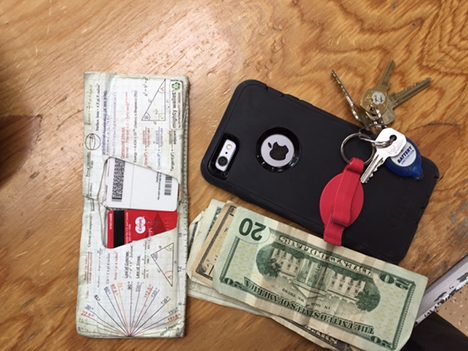
“How do these things work again?”
And don’t even get me started about cell phones. Being at sea is a bit of a throwback to a time (not that long ago), when not everyone had their faces buried in a personal device. Yes, we rely on all sorts of technology while out here, but there something not so offensive about it….but I digress … Generally speaking, being insulated from the continuous onslaught of [mostly bad] news is also a blessing in disguise. For better or worse, I haven’t thought about this year’s presidential election once this past month (insert your favorite presidential candidate joke here). That is not to say that I don’t care, or more importantly, that it has no bearing on our ability to be here, but there is more than a kernel of truth in the old saying, “Ignorance is bliss”. Overall, there is just less to worry about out here. For us , the passengers, that is. The captain, mates, engineers, and seamen worry about our course and our safety. Our food and shelter is well cared for by the stewards department. Life is easy……sort of…..
Now, in contrast to the enjoyment of getting home, there is actually a lot to worry about work-wise once we’re back!! Despite working 14+ hours per day, 7 days per week while on the cruise, we return to work having been out of the office for a month! There’s a lot to catch up on. Add to that all the samples that are being shipped home for further analyses and follow-up work that we have generated as a result of the cruise. Of course, then there is the planning for the next expedition in 18 months, the papers that need to get written, meetings, etc.……Well, it once again makes this life at sea seem so bad after all …..So, thanks for reading, but I had better get to work!……Wait, where’s my wallet?…
Written by Toby Westberry
PMEL Aerosol Group
Aerosols are another name for particulate matter in the atmosphere. Aerosols are important because in clear skies they can scatter sunlight back to space can act to help cool the planet. Aerosols are also important because they can act as a site for water to condense on and form cloud particles. Particles that water can condense on are called Cloud Condensation Nuclei, CCN. In fact the concentration of CCN can greatly affect the optical properties of the cloud that is formed when air is lifted and cooled. If there are a small number of CCN the resulting cloud will have a small number of large droplets. If there are a much larger number of CCN the resulting cloud will have a large number of small droplets. Even though the liquid water concentration in both clouds is the same, the cloud with the large number of small droplets will be much whiter, and reflect more sunlight then the cloud with the small number of large droplets.
It is believed that Aerosols can thus counteract some of the present and future greenhouse warming, and it is vital to understand the processes that create and modify aerosols in the marine atmosphere.
Our group from NOAA-PMEL and the University of Washington JISAO is making measurements of the physical, chemical and optical properties of the aerosols in the marine atmosphere.
The following is a photo tour of some of our instrumentation
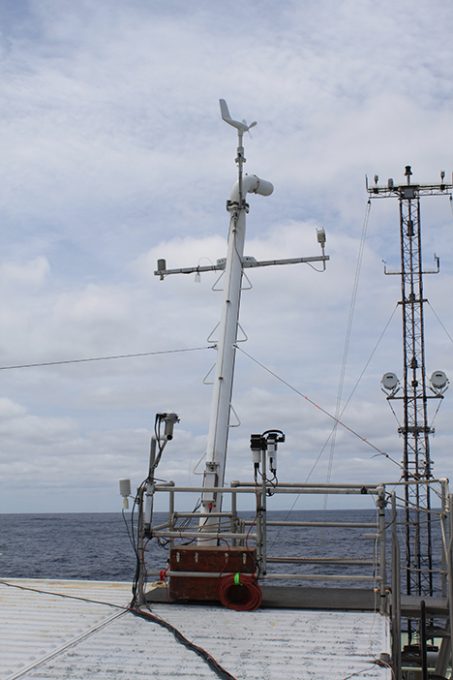
Our aerosol inlet at the top of one of our lab-vans. Our inlet is aerodynamically designed and has a computer controlled motor to keep the inlet pointed into the wind so the large particles do not impact on the side of the inlet. Photo: Jim Johnson
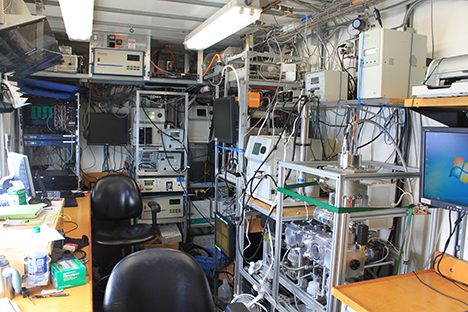
This is the inside of one of our aerosol vans with assorted particle counters, and several devices to measure the particle size spectrum. Photo: Jim Johnson
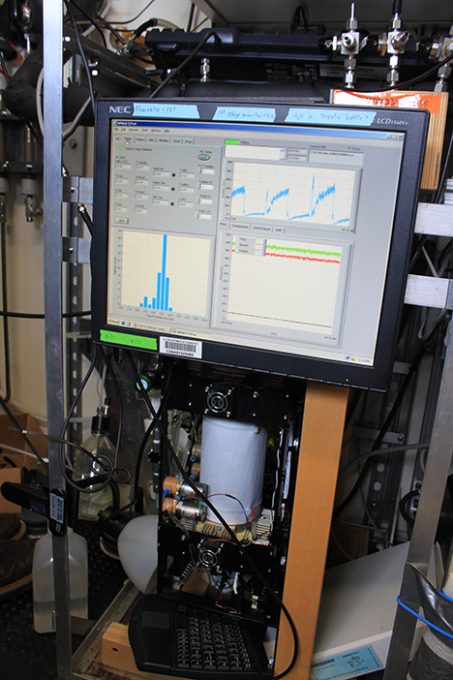
Our Cloud Condensation Nuclei Counter, CCNC, an instrument that takes sample air and raises the humidity to various levels that are just above the condensation point, then it measures concentration of water drops that are formed. Photo: Jim Johnson
Another activity is to help with the launch of the weather balloons. The radiosonde attached to the balloon measures temperature, relative humidity and pressure. The radiosonde also receives GPS to track its motion as it ascends, so that a vertical profile of the horizontal winds can also be derived.
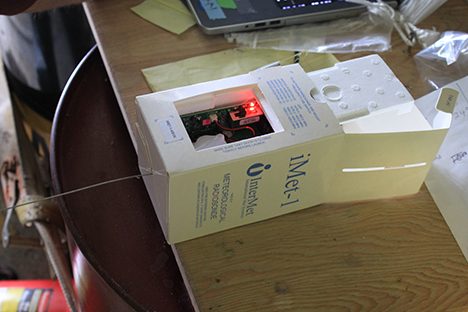
Preparing the radiosonde for launch. Photo: Jim Johnson

A weather balloon is filled with helium and the radiosonde is attached. Photo: Jim Johnson
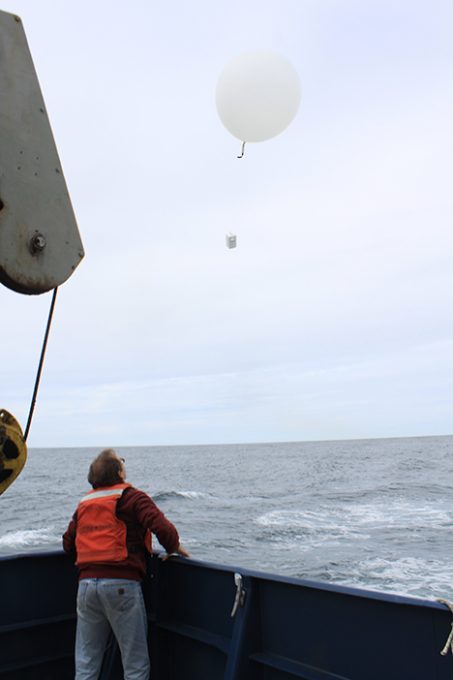
The balloon and radiosonde are walked to the back of the ship’s fantail and released. As the package rises it sends back the data by a radio link to make a vertical profile of temperature, humidity and winds. Photo: Jim Johnson
Written by Jim Johnson
THE BLOW
So far we have been blessed with calm seas and fair winds. We arrived yesterday at our last station, somewhat rested after a 24 hours transit and ready for the grand finale. Neptune had another plan. Half way through the station the winds picked up very quickly, reaching 50 knots with gusts of 60 and the ocean began to build up. The aerosol team got very excited. For oceanographers, the prospect of completing the station looked gloomy. At 11:00 PM I went to the Alvin hanger, the official gathering spot of the nocturnal NCC (NAAMES Coffee Club). All the ‘regulars’ were there with the coffee mugs and it was clear that there would be no overboard deployment of instruments at night (or the day after) so we just sat for a long time, on a pile of crates (aka the bleacher), watching the waves flooding the stern and admiring the power of the ocean. A visit to the bridge provided even more dramatic views of the developing storm.
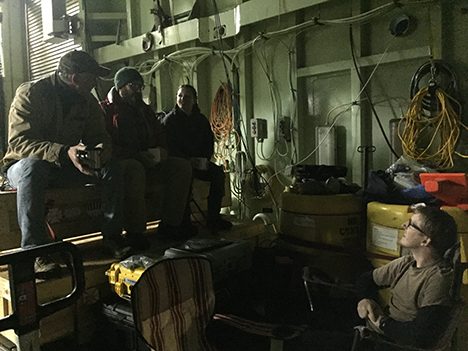
The nocturnal NCC

Images from ‘the blow’ experienced on-board the Atlantis. Photo: Lee Karp-Boss (top left), Nils Haentjens (top right and bottom left), : Cleo Davie-Martin
(bottom right)

A wave splashing on deck of the RV Atlantis during ‘the blow’. Photo: : Cleo Davie-Martin
Twelve hours later, a fully developed sea with 30 ft. waves. Two of the incubators on the fantail got damaged and other items shifted place or were lost for good. No one is allowed on deck. We are rocking and rolling but everyone is still smiling. Lunch required good motor skills and coordination, eating a hamburger while keeping the plate and cup from flying across the table. The lab spaces that normally hustle and bustle with activity are fairly quit today and people take the opportunity to get much needed sleep, process data, relax and play cards. For our team (and the aerosol group) sampling continues through the inline system (described in an earlier blog), pumping seawater into the lab and measuring optical properties, abundances and species composition of plankton. Tomorrow we will begin our journey back to WHOI. Some high seas are still expected but nothing like what we have experienced today.
Written by Lee Karp-Boss (member of the nocturnal NCC)
The Ocean. A chemical soup that covers 70% of the Earth’s surface with a total volume that provides approximately 300 times more space for life than that combined by freshwater and land. Tiny microbes…phytoplankton, zooplankton, bacteria, viruses, but also fish and marine mammals live in that mighty ocean, which is tightly coupled to the atmosphere, the land, the seafloor and every single one of us.
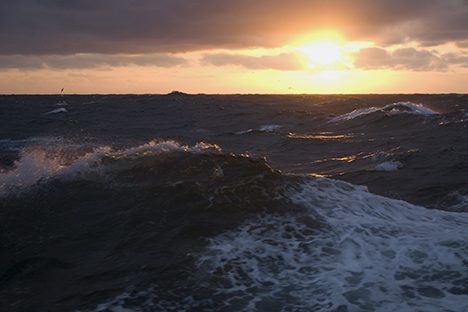
The ocean. This is what we see and sample every day.
No matter where you come from, the ocean has an influence on you. It is not surprising that in all countries directly connected to the ocean or not, people are interested in understanding this dynamic fluid. And here we are on the 12th day of our cruise, a bunch of international scientists from different countries with the same mission: to understand key processes controlling oceanic system function.
Impressed by the diversity of scientists blended together from different countries, today’s ‘experiment’ was to find out how many languages are spoken on board, including the crew which works hard to assure the success of our sampling objectives. I walked around the R/V Atlantis with a single question in mind: in which language can you say the word ‘ocean’? I found out that there are at least 12 languages spoken on the ship: (in alphabetical order) English, Farsi, French, German, Greek, Hebrew, Hindi, Mandarin, Polish, Portuguese, Spanish, and Telugu. However, we share a common passion for understanding the ocean and science is our common language.
Written by Andreas Oikonomou
My eyes begrudgingly opened today around noon and the slow but steady accelerations of the rocking ship made their way into my consciousness. I hardly ever wake feeling thoroughly rested but the excitement of starting another day at sea always drags me out of bed. The start of a work day on-board is always preceded by a large cup of coffee and some time spent enjoying the view on the fantail. As I stepped outside the crisp North Atlantic breeze bit at my face and hands; a small price to pay for such an awesome start to the work day (I mean c’mon, there are people sitting in traffic right now). I observed the seabirds for a while, finished my coffee, and headed into the lab to check the instrument. Two of my co-workers, Tom and Mackenzie, were there hovering over our mass spectrometer (a mass spectrometer is a tool chemists use to detect certain molecules in air). These instruments can be bought off the shelf but in our lab we design and build them ourselves, which I think is totally friggin’ cool. However, that being the case, the thing is constantly broken. Mackenzie was shouting out numbers to Tom who was scribbling them down and I could tell from the tone of their voices that something had indeed gone wrong. After a while, I gathered that one of our pumps that delivers an isotopic standard to the instrument had broken. The inevitable constant barrage of broken instruments and faulty software must be matched by our ability to dream up solutions. Our secret weapon in this battle is our instrument tech and first class ideas man, Cyril McCormick. Cyril represents an infinite source of possible solutions to any issue that may arise. If you think your hot stuff, go ask Cyril how anything electronic works and you’re in for a humbling experience. The chief scientist, Mike Behrenfeld, once casually asked Cyril how an optical mouse worked and got a 4 page report back the next day complete with a schematic.

Mass spectrometer used to measure the chemical composition of aerosols. Photo: Jack Porter

NAAMES-II scientists enjoying the sunset on the aft deck of the RV Atlantis. Photo: Jack Porter

The nighttime view of the RV Atlantis aft deck. Photo: Jack Porter
Written by Jack Porter